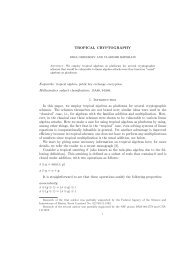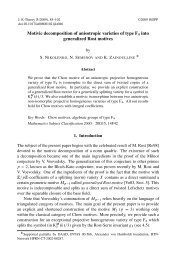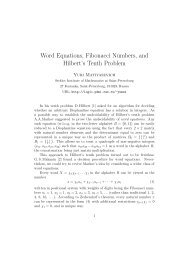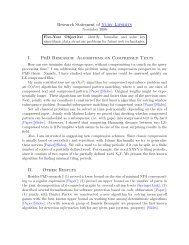Explanation for 'Tree isomorphism' talk
Explanation for 'Tree isomorphism' talk
Explanation for 'Tree isomorphism' talk
- No tags were found...
Create successful ePaper yourself
Turn your PDF publications into a flip-book with our unique Google optimized e-Paper software.
Joint Advanced Student School<strong>Explanation</strong> <strong>for</strong> ‘Tree isomorphism’ <strong>talk</strong>by Alexander Smal (avsmal@gmail.com)Saint-Petersburg, Russia2008
AbstractIn this <strong>talk</strong> we considered a problem of tree isomorphism. We made several attempts tofind a complete invariant <strong>for</strong> rooted trees isomorphism and obtain efficient algorithm fromit. In conclusion, we discussed main ideas of algorithm from “The Design and Analysis ofComputer Algorithms” by Aho, Hopcroft and Ullman [1].The idea of this <strong>talk</strong> is based on [2].1 MotivationIn gene splicing, protein analysis, and molecular biology the chemical structures are oftentrees with millions of vertices. So, the problem of checking whether two structures areequal corresponds to the problem of checking whether two trees are isomorphic. Thus,in mentioned applications difference between O(n), O(n log n), and O(n 2 ) isomorphismalgorithms is not just theoretical importance.2 The idea2.1 Graph isomorphismLet’s start with a definition of graph isomorphism.Definition 1. Isomorphism of graphs G 1 (V 1 , E 1 ) and G 2 (V 2 , E 2 ) is a bijection betweenthe vertex sets ϕ : V 1 → V 2 such that∀u, v ∈ V 1 (u, v) ∈ E 1 ⇔ (ϕ(u), ϕ(v)) ∈ E 2 .There are several common facts about graph isomorphism.• No algorithm, other than brute <strong>for</strong>ce, is known <strong>for</strong> testing whether two arbitrarygraphs are isomorphic.• It is still an open question(!) whether graph isomorphism is N P complete.• Polynomial time isomorphism algorithms <strong>for</strong> various graph subclasses such as treesare known.2.2 Rooted treesWe need a quick way to determine whether two ordinary trees are isomorphic. Consider atrick: let’s convert trees to rooted trees and try to determine whether they are isomorphicas rooted trees. The idea of this trick is that it should be easier to determine rooted treesisomorphism than ordinary trees isomorphism because rooted trees give us a little bit morein<strong>for</strong>mation.
Definition 2. Rooted tree (V, E, r) is a tree (V, E) with selected root r ∈ V .Definition 3. Isomorphism of rooted trees T 1 (V 1 , E 1 , r 1 ) and T 2 (V 2 , E 2 , r 2 ) is a bijectionbetween the vertex sets ϕ : V 1 → V 2 such that∀u, v ∈ V 1 (u, v) ∈ E 1 ⇔ (ϕ(u), ϕ(v)) ∈ E 2 and ϕ(r 1 ) = r 2 .The only difference between graphs and rooted trees isomorphism is that trees isomorphismpreserves root. Here you can see an example of two rooted trees, that are isomorphicas graphs (and as ordinary trees) but not as rooted trees.Example.aBT 1 bA C T 2cLemma 1. If there is O(n) algorithm <strong>for</strong> rooted trees isomorphism, then there is O(n)algorithm <strong>for</strong> ordinary trees isomorphism.Proof.1. Let A be O(n) algorithm <strong>for</strong> rooted trees.2. Let T 1 and T 2 be ordinary trees.3. Let’s find centers of this trees. There are three cases:(a) each tree has only one center (c 1 and c 2 respectively)return A(T 1 , c 1 , T 2 , c 2 )(b) each tree has exactly two centers (c 1 , c ′ 1 and c 2 , c ′ 2 respectively)return A(T 1 , c 1 , T 2 , c 2 ) or A(T 1 , c ′ 1, T 2 , c 2 )(c) trees has different number of centersreturn FalseTo understand this lemma we should define center of tree and propose a way to find it.2.3 Diameter and centerDefinition 4. The diameter of tree is the length of the longest path.Definition 5. A center is a vertex v such that the longest path from v to a leaf is minimalover all vertices in the tree (a half of diameter).Tree centers can be found using simple algorithm.
Contrary instance. Here you can see two trees that have the same number of verticeson each level, but different number of leaves (observation 2 is violated). It means thatconjecture 1 is wrong.aT 1 1 2 · · · n 1 2 · · · n T 2d e D EEach tree has the same number of vertices on each level:1 vertex on level 0, n vertices on level 1 and 2 vertices on level 2,but T 1 and T 2 have different number of leaves (n + 1 and n respectively).3.2 Candidate 2What’s wrong with candidate 1? We didn’t take into account the degree spectrum of atree.Definition 8. Degree spectrum of a tree is the sequence of non-negative integers {d j },where d j is the number of vertices that have j children.Let’s fix it.Conjecture 2. Two trees are isomorphic if and only if they have the same degree spectrum.It seems to be better than first candidate, but. . .Observation 3. Since a tree isomorphism preserves longest paths from the root, the numberof levels in a tree is a tree isomorphism invariant.Using observation 3 we can construct a contrary instance.Contrary instance. This two trees have the same degree spectrum but different numberof levels (observation 3 is violated).aAb c B CAd e 1 D ET 1 1 .T 2.nEach tree has degree spectrum (3, n, 2, 0, . . .): there are 3 vertices with no children,n vertices with only one child and 2 vertices with 2 children,but T 1 has n + 2 levels whereas T 2 has only n + 1 levels.n
3.3 Candidate 3What’s wrong with candidate 2? We used some integral property <strong>for</strong> it. Consider an analogy:algorithm <strong>for</strong> determining whether two integer arrays are equal which just comparestheir sums. Obviously, it is a wrong algorithm.Conjecture 3. Two trees are isomorphic if and only if they have the same degree spectrumat each level.This conjecture is very tricky. If two trees have the same degree spectrum at each level,then they must automatically have the same number of levels, the same number of verticesat each level, and the same global degree spectrum!Observation 4. The number of leaf descendants of a vertex and the level number of avertex are both tree isomorphism invariants.And again using observation 4 we can construct a contrary instance.Contrary instance. You can see two trees below that have the same degree spectrum ateach level but on level 2 in T 1 there are two vertices, b and c, with 2 and n + 2 descendantsrespectively and in T 2 there are two vertices, B and C, with n + 3 and 1 descendantsrespectively. So, observation 4 is violated.level degree spectrumaAb c B Cd e f D E FT 1g 1 G 1 T 2(0, 0, 1, 0, . . .)(0, 1, 1, 0, . . .)(2, 0, 1, 0, . . .)(1, 1, 0, 0, . . .).n.n.(1, 0, 0, 0, . . .)4 AHU algorithmWe have failed tree times. Let’s look <strong>for</strong> some existing algorithm and understand it.4.1 Algorithm by Aho, Hopcroft and UllmanThis algorithm is from [1]. There are two main properties of this algorithm.• Determine tree isomorphism in time O(|V |).• Uses complete history of degree spectrum of the vertex descendants as a completeinvariant.
The idea of AHU algorithm. The AHU algorithm associates with each vertex a tuplethat describes the complete history of its descendants.Hard question.Why our previous invariants are not complete?Answer. We discussed weakness of first two candidates. The third invariant was betterthan second but it also uses some integral properties.Our plan. Let’s discuss AHU algorithm. We start from O(|V | 2 ) version and then wediscuss how to make it faster (O(|V |)).4.2 Understanding AHU algorithmsKnuth tuples. Let’s assign parenthetical tuples to all tree vertices.Knuth tuples example. Knuth tuples are very intuitive easy. So, <strong>for</strong>mal definition isunnecessary. Let’s consider an example.A ( ((0)) ((0) (0)) (0) )B ((0)) C ( (0) (0) )D (0)E (0) F (0) G (0)You should have noticed that all leaves have (0) labeland each non-leafs label consists of children tuples enclosed in parentheses.There is an algorithm Assign-Knuth-Tuples that visits every vertex once or twice.Algorithm.Assign-Knuth-Tuples(v)1: if v is a leaf then2: Give v the tuple name (0)3: else4: <strong>for</strong> all child w of v do5: Assign-Knuth-Tuples(w)6: end <strong>for</strong>7: end if8: Concatenate the names of all children of v to temp9: Give v the tuple name tempObservation 5. There is no order on parenthetical tuples.Why do we need an order? Let’s consider an example.
Example.Here you can see two isomorphic trees with assigned Knuth tuples.A ((0)((0))) a (((0))(0))B (0)C((0)) b ((0))c(0)D (0)d(0)We know that trees are isomorphic but roots have different assigned tuples. Let’sconvert parenthetical tuples to canonical names. We should drop all “0”-s (zeros are notnecessary) and replace “(” and “)” with “1” and “0” respectively.A 1 10 1100 0 a 1 1100 10 0B10C1100 b 1100c10D10d10Canonical names are just numbers. So, we can sort them. Let’s sort canonical namesof children <strong>for</strong> each non-leaf node.A 1 10 1100 0 a 1 10 1100 0B10C1100 b 1100c10D10Roots has the same assigned canonical names.There is an algorithm Assign-Canonical-Names that visits every vertex once ortwice (it is a modification of Assign-Knuth-Tuples).Algorithm. Assign-Canonical-Names(v)1: if v is a leaf then2: Give v the tuple name “10”3: else4: <strong>for</strong> all child w of v do5: Assign-Canonical-Names(v)6: end <strong>for</strong>d10
7: end if8: Sort the names of the children of v9: Concatenate the names of all children of v to temp10: Give v the name 1temp0Conjecture 4. Two trees are isomorphic if and only if they have the same canonical nameassigned to root.We should discuss some important questions.Invariant?Is canonical name of a root a tree isomorphism invariant?Answer.to root.Yes. Obviously, two isomorphic trees have the same canonical name assignedIs canonical name of a root a complete tree isomorphism invari-Complete invariant?ant?Answer. Yes. We can show it easily by reconstructing tree from root canonical name.So, there is a bijection between tree and roots canonical names.Algorithm. AHU-Tree-Isomorphism(T 1 , T 2 )1: r 1 ← root(T 1 )2: r 2 ← root(T 2 )3: Assign-Canonical-Names(r 1 )4: Assign-Canonical-Names(r 2 )5: if name(r 1 ) = name(r 2 ) then6: return True7: else8: return False9: end if4.3 AHU algorithm improvementObservation 6. Consider a tree of n vertices in one long strand. Time needed to computethe root name of this tree is proportional to 1 + 2 + · · · + n, which is Ω(n 2 ).This observation shows that AHU-Tree-Isomorphism is O(|V | 2 ). But there is a waywe can improve it to be O(|V |).Observation 7. For all levels i, the canonical name of level i is a tree isomorphisminvariant.
Observation 8. Two trees T 1 and T 2 are isomorphic if and only if <strong>for</strong> all levels i canonicallevel names of T 1 and T 2 are identical.Using this two observations. . .The idea 1. Assign canonical names <strong>for</strong> level, sort by level, and check by level that thecanonical level names agree.The idea 2. Assign canonical names <strong>for</strong> level and if canonical level names agree thanreplace canonical names with integers.These ideas show us how improve AHU-Tree-Isomorphism to make it O(|V |). Usingunique integers on each level instead of strings we can get rid of effect we discoveredin observation 6. On slides you can find animated demo of AHU-Tree-Isomorphismalgorithm work.But. . . There is a hole in our discussion — we have <strong>for</strong>gotten about sorting in Assign-Canonical-Names. So, in this case AHU-Tree-Isomorphism is just O(n log n). . . Butthere is a way to sort canonical names in linear time — you can read about it in [1].5 Resume• We have made three unsuccessful attempts to construct complete tree isomorphisminvariant.• We discussed O(|V | 2 ) version of AHU algorithm.• We discussed ways of AHU algorithm improvement to make it work in O(|V |) time.References[1] A. Aho, J. Hopcroft, and J. Ullman The Design and Analysis of Computer Algorithms.Addison-Wesley Publishing Co., Reading, MA, 1974, pp. 84-85.[2] D.M. Campbell, D. Rad<strong>for</strong>d, Tree isomorphism algorithms: Speed vs. clarity. Math.Mag. 64, No. 4, 1991, pp. 252-261.











